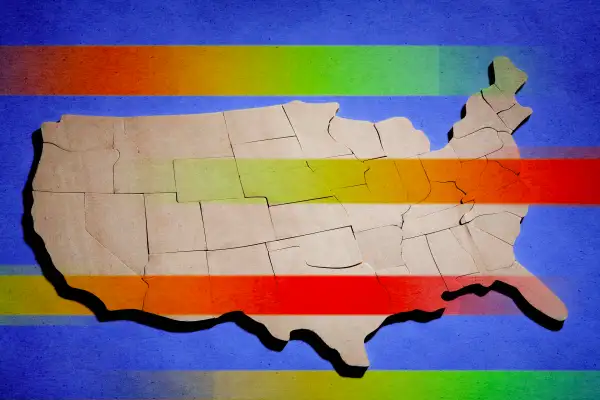This Map Shows the Average Credit Score in Every State. How Do You Stack Up?

Where you live can say a lot about your credit score.
For example, if you live in the South, you’re more likely to have a credit score of just under 700, which falls into the range of “good,” according to the credit data company FICO, but is below the national average of 714.
And if you live in the Northeast, you probably have a credit score higher than the national average.
According to data from Experian — one of the three major credit bureaus — all states on average have at least a “good” FICO score, but only one state has a score that’s considered “very good.”
FICO scores range from 300 to 850, and are broken down into five categories of poor to exceptional. FICO says a “good” score is any one between 670 and 739, and a “very good” one is between 740 and 799.
Here’s a closer look at the average FICO scores of each state.
Average credit score by state
On a state-by-state basis, average credit scores run from a low of 680, in Mississippi, up to a high of 742, in Minnesota.
- Mississippi: 680
- Louisiana: 689
- Alabama: 691
- Oklahoma: 693
- Texas: 693
- Arkansas: 694
- Georgia: 694
- South Carolina: 696
- New Mexico: 699
- West Virginia: 700
- Kentucky: 702
- Nevada: 702
- Tennessee: 702
- Florida: 707
- North Carolina: 707
- Arizona: 712
- Indiana: 712
- Missouri: 712
- Ohio: 715
- District of Columbia: 716
- Maryland: 716
- Michigan: 718
- Illinois: 719
- California: 721
- Kansas: 721
- New York: 721
- Virginia: 721
- Alaska: 723
- Pennsylvania: 723
- Rhode Island: 723
- Wyoming: 723
- New Jersey: 724
- Connecticut: 725
- Delaware: 725
- Idaho: 727
- Maine: 728
- Iowa: 729
- Colorado: 730
- Utah: 730
- Montana: 731
- Nebraska: 731
- Hawaii: 732
- Massachusetts: 732
- Oregon: 732
- North Dakota: 733
- New Hampshire: 734
- South Dakota: 734
- Washington: 735
- Wisconsin: 735
- Vermont: 736
- Minnesota: 742
Credit score by generation
Age also plays an important part in credit scores.
Given that the length of one’s credit history is one of the core factors that determines someone’s credit score, it should come as no surprise that older generations tend to have higher scores than younger ones.
Here are the average credit scores by generation:
- Gen Z (born 1997-2012): 697
- Millennials (born 1981-1996): 687
- Gen X (born 1965-1980): 706
- Baby boomers (born 1946-1964): 742
- Silent generation (born 1928-1945): 760
Why it’s important to track your credit
Your credit score is extremely important. Like it or not, those three little digits have an outsize impact on your financial life.
Beyond the more obvious uses of a credit score like qualifying for an auto loan or mortgage, your score may also be used by landlords to determine your rent or security deposit requirements — or whether to rent to you at all. Many insurance companies also look at your score to set your premiums. Your credit report (but not your score) can also be factored into decisions by employers on whether to promote or hire you.
In today’s high interest rate environment, lenders are tightening their standards. That means it’s becoming increasingly difficult to get approved for a loan, leading some financial experts to warn of a “credit crunch.” In such cases, lenders may only want to lend to people with exceptional credit scores.
Keeping tabs on your credit goes beyond simply checking your credit score (which you can do for free through a variety of apps, directly through the three credit bureaus, or through your credit card provider). You’ll also want to pull your credit reports frequently to check under the hood, so to speak.
Your credit report often does not include your credit score, but it shows you crucial information about your outstanding debts, credit history and more. Until the end of 2023, you can check your credit report for free once per week with the big three credit bureaus at annualcreditreport.com
Ways to improve your credit score
If your credit score isn’t where you want it to be, there are luckily several ways you can improve it. Many of them will take some time, however.
One of the first steps you’ll want to take to improve your credit score is to pull your credit report. If it contains outdated, incomplete or incorrect information, you can dispute the information and remove negative items from your credit report. This move alone could drastically improve your score, depending on what information was removed.
If you pull your report and the information is correct, you may need to take more long-term strategies to boost your score, such as ensuring your bills are paid on time, keeping your credit utilization (read: balances) low or enrolling in a credit-score boosting program like Experian Boost. Credit boosting programs allow you to add on-time payments for rent, utilities, Wi-Fi or even Netflix to your credit report — potentially raising your score for things you’re already doing.
More on Credit & Credit Repair
Money’s Top Selection Guides for Improving Your Credit
Money’s Credit Repair Companies Reviews |

